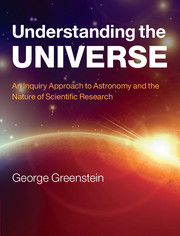Book contents
- Frontmatter
- Contents
- Preface
- Acknowledgments
- Part I Introducing steps to astronomy
- Part II The Solar System
- Part III Introducing stars
- Part IV Introducing galaxies and the Universe
- 16 The Milky Way Galaxy
- 17 Galaxies
- 18 Cosmology
- 19 Life in the Universe
- Epilog
- Appendix I The small-angle formula
- Appendix II Exponential notation
- Appendix III The Solar System
- Appendix IV The closest and brightest stars
- Appendix V Physical and astronomical constants
- Appendix VI Conversion factors
- Appendix VII Constellation maps
- Glossary
- Figure Credits
- Index
- Plate section
16 - The Milky Way Galaxy
from Part IV - Introducing galaxies and the Universe
Published online by Cambridge University Press: 05 February 2013
- Frontmatter
- Contents
- Preface
- Acknowledgments
- Part I Introducing steps to astronomy
- Part II The Solar System
- Part III Introducing stars
- Part IV Introducing galaxies and the Universe
- 16 The Milky Way Galaxy
- 17 Galaxies
- 18 Cosmology
- 19 Life in the Universe
- Epilog
- Appendix I The small-angle formula
- Appendix II Exponential notation
- Appendix III The Solar System
- Appendix IV The closest and brightest stars
- Appendix V Physical and astronomical constants
- Appendix VI Conversion factors
- Appendix VII Constellation maps
- Glossary
- Figure Credits
- Index
- Plate section
Summary
So far in this book we have surveyed what might be called our corner of the Universe: a region of space extending outward several thousand light years. An important result of that survey was that there was no overall pattern to the distribution of stars in space. Stars were found to scatter essentially randomly about us.
In this chapter we extend our survey much farther – out to roughly one hundred thousand light years' distance. In doing so we will reach a dramatically different conclusion. In a survey over such gigantic distances, a pattern emerges. We will find that everything we have so far studied – the Earth, the Sun and all the Solar System; the stars visible to the naked eye and the far more distant stars that telescopes reveal – all these are part of an enormous structure: the Milky Way Galaxy.
The discovery of our Galaxy is one of the triumphs of twentieth-century astronomy. But why was the Galaxy so difficult to discover? After all, we live within it! One answer is that much of the Galaxy is hidden from our view by interstellar clouds. But another reason is simply that it is so big. The Milky Way Galaxy is too big to see. Until recently we had been something like a race of intelligent ants, crawling across the face of a mountain but completely unaware of its existence.
Constituents of the Galaxy
Before recounting the story of this discovery it is worthwhile to pause a moment, and review the state of our knowledge at the time of the discovery of the Milky Way Galaxy. Of what did the astronomical Universe, as understood at the time, consist?
So far in this book we have encountered:
planets, moons, etc.;
stars;
clusters of stars – two types are known: so-called “open clusters” such as the Pleiades (Figure III.2) and “globular clusters” (Figure III.3);
interstellar clouds (e.g. Figure 13.1);
remnants of stellar explosions: planetary nebulae (Figure 15.5) and supernova remnants (Figure 15.21).
- Type
- Chapter
- Information
- Understanding the UniverseAn Inquiry Approach to Astronomy and the Nature of Scientific Research, pp. 453 - 487Publisher: Cambridge University PressPrint publication year: 2013



